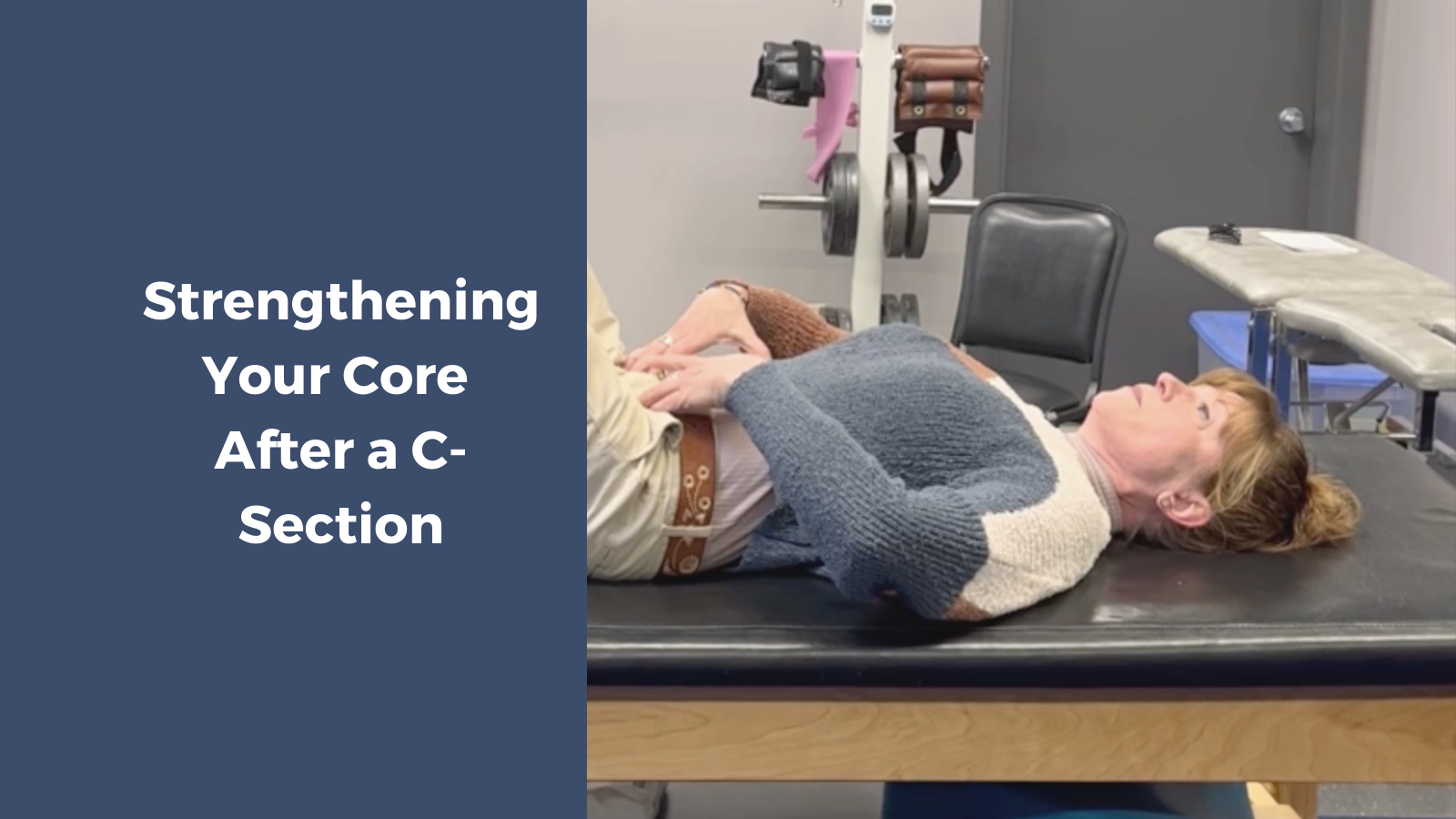Mangiarelli Rehabilitation Physical Therapy Blog
Physical Therapy for Perineal Tears
A perineal tear during childbirth is common during vaginal delivery, involving stretching or tearing of the perineum, the area between the vagina and anus. Perineal tears can lead to pelvic floor dysfunction, urinary or fecal incontinence, and painful sex. The risk of suffering a perineal tear is heightened if you are a first-time mom, had prolonged pushing during labor, delivered a large baby, used forceps during delivery, or if mom is of an older maternal age. Pelvic floor therapy with a physical therapist is one of the most effective and efficient ways to treat perineal pain after childbirth and restore function and strength to the pelvic floor muscles.
Physical Therapy after a C-Section [Infographic]
A C-section is major abdominal surgery involving the delivery of a baby through horizontal incisions made in the abdomen or uterus along the pubic hairline. Women can experience significant pain at the c-section incision site due to scar tissue formation, limiting mobility in the abdominal area and contributing to pelvic pain and pelvic floor dysfunction. After a c-section, physical therapy can play a critical role in helping women recover, reducing incision site pain, normalizing pelvic floor muscle tone, improving core and back muscle strength, and optimizing women’s function and mobility.
How Pelvic Floor Therapy Can Support Women with Endometriosis
March is National Endometriosis Awareness Month. Endometriosis is a condition that occurs when the endometrium grows outside of the uterus in the pelvic and abdominal areas, causing inflammation, pain, and adhesions in the pelvic area. Endometriosis can also cause muscles in the pelvis to tighten, spasm, and thicken as they respond to tension patterns from the condition, causing pelvic floor dysfunction. Pelvic floor therapy can help alleviate pelvic floor symptoms related to endometriosis, reducing endometriosis-related pelvic pain and pelvic floor muscle tightness, minimizing “endo belly” occurrence, addressing urinary and bowel issues, and helping make sex less painful through targeted reconditioning of the pelvic floor muscles.
Female Athlete Triad Physical Therapy
Female athlete triad involves three interrelated conditions: energy availability, bone mineral density, and the menstrual cycle. Energy availability is the cornerstone of the triad as low energy and nutrient deficiencies can lead to the development of low bone density and changes in the menstrual cycle in female athletes. Physical therapy can help to prevent or resolve female athlete triad, screening for triad risk as they treat female athletes, identify signs, address triad-related injuries, and educate athletes on proper health and fitness for their overall health and athletic training.
The Role of Exercise in Osteoporosis Treatment
Exercise is a critical component of osteoporosis management. Osteoporosis is a condition that causes bones to become thin, brittle, and more susceptible to fractures. Exercise places beneficial stress on bones, causing them to thicken and grow stronger in response. Experts recommend combining weight-bearing exercise and strength training for optimal management of osteoporosis through exercise. A physical therapist cans guide osteoporosis patients through a customized, safe, and effective exercise program to combat osteoporosis.
Physical Therapy for Episiotomy and Perineal Tears
A perineal tear or an episiotomy during childbirth can lead to pelvic floor dysfunction, urinary or fecal incontinence, and painful sex. An episiotomy is a surgical incision of the perineum to make more space for the baby, while a perineal tear involves natural stretching or tearing of the perineum, the area between the vagina and anus, during birth. Physical therapy is an effective treatment for perineal tearing or an episiotomy, using pelvic floor rehabilitation to restore function and strength to the pelvic floor muscles and address pain and incontinence. Mangiarelli Rehabilitation physical therapist Jen explains what an episiotomy is and how physical therapy can help you heal after an episiotomy or perineal tear.
Strengthening Your Core After a C-Section
The rate of c-section deliveries is steadily increasing, comprising over 30% of births in the United States in the last year. A c-section is a major surgery involving a horizontal incision just above the pubic bone that can negatively impact core muscle function and strength. Following a c-section, it’s critical to gradually retrain and strengthen the core under the guidance of a physical therapist. In the video below, Mangiarelli Rehabilitation physical therapy assistant Patti explains how to safely strengthen your core after a c-section delivery.
Core Strengthening During Pregnancy
Mangiarelli Rehabilitation physical therapist and pregnant mom, Sarah, demonstrates 5 safe core strengthening exercises you can perform safely during pregnancy. Building a strong core during pregnancy can help you manage the demands of pregnancy on the body and minimize diastasis recti and other pregnancy symptoms. Strengthening your core during pregnancy not only helps support your pelvic organs as your baby grows and alleviates pressure on the back but can also help with the physical demands of labor.
Postpartum Bladder Health: How Physical Therapy Can Help
Physical therapy can treat postpartum bladder problems, such as urinary incontinence, by restoring pelvic floor muscle function after pregnancy and childbirth. Between 30 to 40% of women experience some degree of urinary incontinence postpartum, often silently suffering through stress incontinence in which urine may leak without your control when pressure is applied to the bladder when laughing, coughing, or exercising. Women can find relief from postpartum bladder issues by working with a skilled physical therapist.
Physical Therapy After a C-Section Delivery
Having a baby is a joyful, special event in the life of a mother. However, the process of delivery and recovery post-delivery can be challenging, particularly if a mother has undergone a c-section delivery. Women may experience pain at the c-section incision site, low back pain, urinary continence, and pelvic floor muscle weakness following a c-section. Physical therapists can provide women customized physical therapy treatment to address these issues, relieving incision pain through soft tissue mobilization techniques and strengthening the core, back, and pelvic floor muscles through an exercise program.
Physical Therapy for Postpartum Diastasis Recti
Diastasis Recti is a common condition that can affect women during and after pregnancy. It involves the separation of the rectus abdominis muscle, causing the connective tissue to stretch and resulting in weakness in the midsection and a visible, palpable gap in the abdominal muscle. Physical therapy offers safe, effective treatment for diastasis recti to improve strength, control, and function of the abdominal muscles. On the blog, physical therapist, Jen, and PTA, Patti, demonstrate safe exercises to address diastasis recti.
How Physical Therapy Can Treat Women’s Health Conditions
A woman’s body undergoes tremendous changes throughout the course of her lifetime, particularly during childbearing and childbirth. These changes can lead to pain and muscle dysfunction of the pelvic floor. Too often, women are dismissed when they raise concerns over incontinence, chronic pelvic pain, or painful intercourse and continue to suffer these symptoms untreated for months and even years. Women no longer have to suffer in silence. Physical therapy is an effective treatment to address pelvic floor dysfunction and other women’s health conditions.

![Physical Therapy after a C-Section [Infographic]](https://images.squarespace-cdn.com/content/v1/5e419cdc97af032560004b99/1684179845687-YIW6AAG3G4MSFF08KSB7/TW+C-Section+Infographic.png)





















